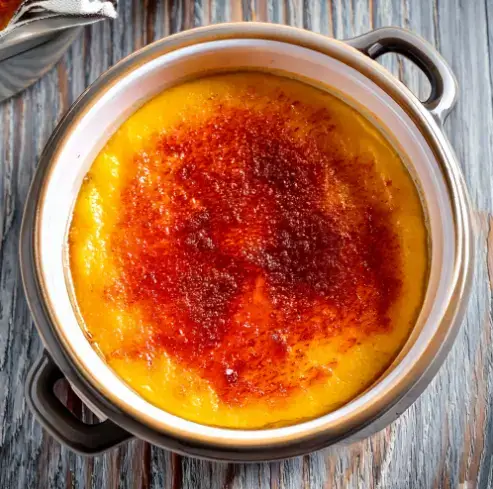Introduction: Understanding Crème Brûlée and Custard
When it comes to creamy, luxurious desserts, two names frequently rise to the top of the list: crème brûlée and custard. Both of these indulgent treats are celebrated for their velvety textures and rich, flavorful profiles that make them irresistible to dessert lovers. Whether served as the finale to a gourmet meal or enjoyed as a simple comfort after a busy day, both crème brûlée and custard have earned their place as iconic sweets in the world of desserts. But, despite their similar creamy appeal, many people wonder if these two desserts are essentially the same.
In reality, while crème brûlée and custard may look alike on the surface, they are far from identical. Though they share common ingredients and a similar custard-like consistency, the subtle yet important differences in their preparation methods, textures, and presentations set them apart. Whether it’s the signature caramelized sugar topping of crème brûlée or the smooth, rich texture of custard, each dessert offers a distinct experience that will appeal to different tastes and occasions.
As we explore the world of crème brûlée and custard, we’ll dive into what makes each dessert unique. From their origins and key ingredients to their preparation techniques and cultural significance, this guide will help you understand the distinctions and similarities between these two beloved treats. By the end, you’ll have a clearer understanding of which dessert suits your preferences, whether you’re craving the elegance of a crème brûlée or the comforting simplicity of a classic custard. Let’s dive in and uncover what makes each of these desserts so special!
Exploring the Similarities and Differences
Though both crème brûlée and custard are creamy and delicious, their preparation methods, ingredients, and textures differ. Crème brûlée is celebrated for its signature caramelized sugar crust that adds a satisfying crunch to the smooth custard base. In contrast, custard is known for its silky consistency and versatility, often used in various dishes across many cultures.
What’s in Store in This Guide
In this guide, we will take an in-depth look at the origins, ingredients, preparation techniques, and textures of both desserts. We’ll break down the key differences and similarities that define each dessert and explore when each is best enjoyed. By the end of this article, you’ll have a better understanding of what makes crème brûlée and custard unique, helping you decide which one is perfect for your next indulgent treat. Whether you’re a long-time fan of these desserts or new to the world of custardy creations, this guide will provide the insights you need to make an informed choice.
Let’s begin our exploration of crème brûlée vs. custard and discover what makes each dessert special!
What is Crème Brûlée? A Classic French Dessert
Crème Brûlée Definition and Origins: The History of Burnt Cream
Crème brûlée, a classic French dessert, translates to “burnt cream.” This elegant treat boasts a smooth custard base topped with a caramelized sugar crust. While its exact origins remain debated, many credit France for its creation, though similar desserts like Trinity Cream from England and Crema Catalana from Spain share close ties.
Over the centuries, chefs and home cooks alike have associated crème brûlée with sophistication, often serving it at fine dining establishments.
Key Ingredients in Crème Brûlée: What Makes It Unique?
Crème brûlée relies on a few simple ingredients to achieve its rich, indulgent flavor:
- Heavy cream: Forms the base for its luxurious texture.
- Egg yolks: Provide structure and smoothness.
- Granulated sugar: Sweetens and caramelizes for the crust.
- Vanilla: Infuses a subtle aromatic depth.
With just these essentials, crème brûlée delivers the perfect balance between creamy and crunchy.
Cooking Technique
The preparation of crème brûlée distinguishes it from other desserts. Cooks bake the custard in a water bath to ensure even cooking and prevent curdling. After chilling, they sprinkle sugar over the custard and caramelize it with a blowtorch or broiler. This final step creates the signature crisp crust that contrasts beautifully with the silky base.
What is Custard?
Definition and Variations
Custard encompasses a wide range of desserts made from eggs, milk or cream, and sugar. Unlike crème brûlée, custard comes in many forms, including baked, stirred, and frozen varieties like ice cream. This versatility ensures custard’s presence in countless cuisines worldwide.
Common Ingredients
Custard recipes often feature ingredients similar to those in crème brûlée, with slight variations in proportions:
- Milk or cream: Forms the base, typically lighter than crème brûlée.
- Whole eggs or yolks: Thicken the mixture.
- Sugar: Adds sweetness.
- Flavorings: Options include vanilla, nutmeg, chocolate, or fruit purees.
Types of Custards Around the World
Custard adapts easily to different culinary traditions. For example:
- Flan: A baked custard with caramel sauce, popular in Latin America.
- Crème Anglaise: A pourable custard sauce often paired with cakes and puddings.
- Pastry Cream: A thicker custard used in éclairs and tarts.
- Crema Catalana: A Spanish dessert similar to crème brûlée but flavored with citrus and cinnamon.
Custard’s versatility allows it to appear in diverse dishes, making it a favorite among chefs and home bakers alike.
Crème Brûlée vs Custard: Key Differences
Ingredients and Ratios
The primary difference between the two lies in their ingredients. Crème brûlée uses heavy cream, giving it a richer taste and texture. Custard, on the other hand, often incorporates milk, resulting in a lighter consistency.
Texture and Appearance
Crème brûlée stands out with its creamy texture and caramelized sugar crust. The topping not only enhances its flavor but also provides a satisfying crunch.
Custard, however, varies widely in texture. Baked custards like flan feel firmer, while stirred versions like crème anglaise are silky and pourable. Unlike crème brûlée, most custards lack a hardened sugar layer unless prepared as a variation like crema catalana.
Cooking Methods
The cooking methods for these desserts further emphasize their differences. Chefs always bake crème brûlée in a water bath before caramelizing the sugar topping.
In contrast, custard allows for more preparation styles. It can be baked, stirred on the stovetop, or steamed, offering a range of textures and applications. This flexibility makes custard suitable for diverse recipes.
Similarities Between Crème Brûlée and Custard
Shared Ingredients
Despite their differences, both desserts share a common foundation. The combination of eggs, cream or milk, sugar, and flavorings creates their signature creamy texture and rich taste.
Creamy, Egg-Based Desserts
Additionally, both crème brûlée and custard belong to the family of creamy, egg-based desserts. Their smooth textures and indulgent flavors continue to delight dessert lovers worldwide.
Versatility in Flavors
Another shared feature is their ability to adapt to various flavor profiles. Both desserts shine when infused with ingredients like chocolate, coffee, citrus zest, or spices, offering endless possibilities for customization.
Which One Should You Choose?
For a Rich, Decadent Treat
Crème brûlée serves as the perfect choice for those seeking indulgence. Its caramelized sugar topping and velvety custard base make it an excellent option for special occasions.
For Versatility and Simplicity
Custard, on the other hand, suits those who value versatility. You can enjoy it on its own or incorporate it into pies, trifles, and other desserts.
When to Serve Each Dessert
To decide, consider the occasion:
- Choose crème brûlée for elegant dinners or romantic evenings.
- Opt for custard for casual family meals or as a base for other desserts.
Fun Facts About Crème Brûlée and Custard
- Did you know? People traditionally crack the caramelized crust on crème brûlée with a spoon before eating.
- Custard forms the base for many ice creams, contributing to their creamy texture.
- Crème brûlée gained widespread popularity in the 1980s, becoming a hallmark of upscale restaurants.
Conclusion
So, is crème brûlée the same as custard? While crème brûlée technically belongs to the custard family, its distinct preparation methods, rich cream base, and signature caramelized sugar topping set it apart from other custard-based desserts. Crème brûlée is not just a custard; it’s an experience, with the satisfying crack of the sugary crust contrasting perfectly with the smooth custard underneath.
Both desserts have their own unique charm. Crème brûlée is perfect for those who enjoy a little elegance and drama in their desserts, with its crunchy top providing a delightful textural contrast to the creamy base. On the other hand, custard is incredibly versatile and can be enjoyed in many forms, from classic stirred custards to baked varieties and even as a filling for pastries. It’s a dessert that can adapt to any occasion, whether served alone or as part of another dish.
If you’re still unsure about which dessert to choose, why not try both? Making them at home can be a fun experiment in the kitchen, and you might just discover your new favorite dessert. Whether you opt for the luxurious, crunchy crème brûlée or the comforting simplicity of custard, both offer an indulgent treat that will satisfy your sweet tooth.
We’d love to hear your thoughts! Have you made crème brûlée or custard before? What was your experience? Do you have a favorite recipe or some helpful tips for perfecting these classic desserts? Share your thoughts and culinary adventures in the comments below. We’re excited to hear from you and continue the conversation on these delicious, timeless treats.
FAQs
Is Crème Caramel and Crème Brûlée the Same Thing?
No, crème caramel and crème brûlée are not the same. While both are creamy, egg-based desserts, the main difference lies in the caramel topping. Crème caramel has a soft caramel layer that forms at the bottom during baking, while crème brûlée features a crisp, caramelized sugar crust on top, created by using a blowtorch or broiler.
Is Crème Brûlée the Same as Custard?
Crème brûlée is a type of custard, but it’s not the same as all custards. Both desserts share similar ingredients like eggs, cream, and sugar, but crème brûlée has a richer texture due to its use of heavy cream and a crispy caramelized sugar top. Custard, in general, can be made in various forms, including pourable (like crème anglaise) or firm (like flan), without the caramel crust.
What Are the Three Types of Custard?
The three main types of custard are:
- Stirred Custard: Cooked on the stovetop and thickened by eggs (e.g., crème anglaise).
- Baked Custard: Cooked in the oven, often in a water bath, resulting in a firmer texture (e.g., flan).
- Pastry Cream: A thickened custard used as a filling in pastries, tarts, and cakes.
What Is Another Name for Crème Brûlée?
Another name for crème brûlée is “burnt cream,” which directly translates from the French term “crème brûlée.” This name refers to the dessert’s signature caramelized sugar crust, which gives it a “burnt” appearance.

